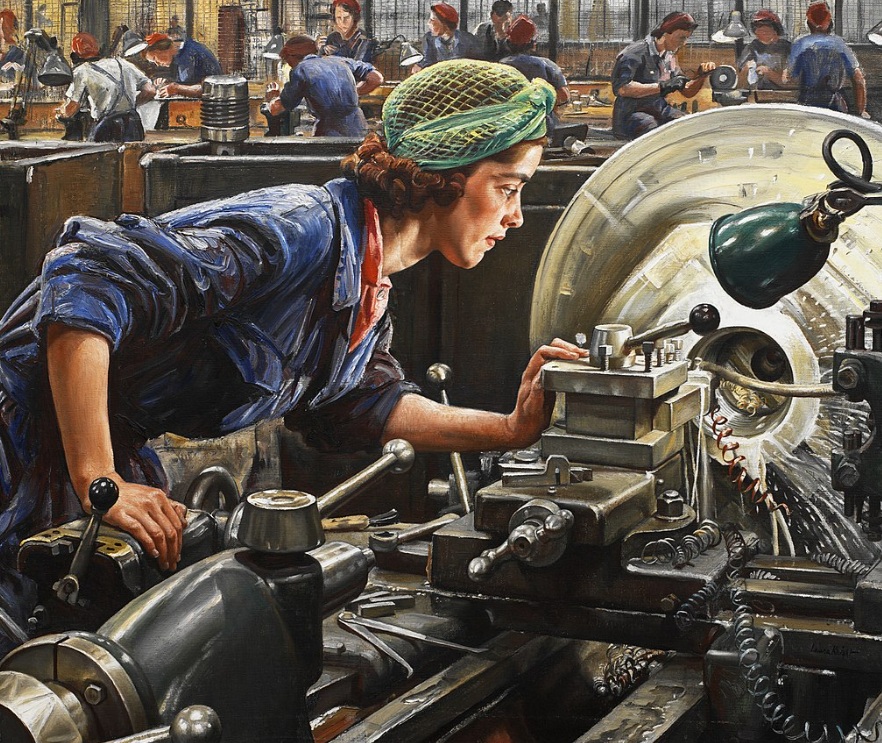Hidden in plain sight

|
| Ruby Loftus screwing a breech-ring (detail, 1943) by Laura Knight. (Photo: Imperial War Museum). |
In 1844, the American writer NP Willis coined the term ‘The Upper Ten’. Short for the ‘The Upper Ten Thousand’, it denoted the prosperous two per cent elite of New York’s population. The term was soon applied in Britain to the government, aristocracy, landed gentry and leaders of such august bodies as the Church of England and the Jockey Club. In 1864, Anthony Trollope in his novel Can You Forgive Her? added a refinement of ‘The Upper Ten Hundred’ for the blue-blooded, as opposed to those with regulation red.
One feature of Upper Ten was that, before about 1900, it formed the principal client group for portraits. While some (maybe the Upper Upper Ten) might have aspired to family portraits by Van Dyke and Lely, Reynolds and Gainsborough, Lawrence, Leighton and Sargent, many had to make do with artists of lesser celebrity, more than 1,000 of whom, documentary evidence shows, were women. Where are all these portraits by women? I suggest that they are hidden in plain sight in the galleries, mansions and collections of the nation, disguised as ‘artist unknown’, ‘English School’ and ‘attributed to Allan Ramsay’.
I pick this last name not out of a hat but straight from the exhibition at Tate Britain Now You See Us: women artists in Britain, 1520–1920, where it forms a rather pathetic example. The intent of the exhibition is to restore women artists to their rightful place in the history of art and show how hard-earned it was, with the many impediments imposed by lack of formal training, societal norms, narrow-minded husbands and the art establishment.
Despite Mary Moser and Angelica Kauffman being founder members of the Royal Academy in 1768, and the annual exhibition regularly featuring women’s works in prime eyeline positions, the third woman to be elected was not until 1936: Laura Knight.
This was long overdue, seven years after recognition by the state through her DBE. The full range of her virtuosity and versatility was recently championed at the exhibition I Paint Today at Worcester City Art Gallery. Early watercolours, landscapes, still lifes, theatre backstages, circuses, posters for London Transport and portraits, not least two beautifully reflective ones of George Bernard Shaw and the gypsy, Beulah Smith.
Laura Knight knew she was a pioneer for the emancipation of women in art. In 1913, she set a trap for the Royal Academy and it walked straight in. She submitted her Self-portrait with Model to the Summer Exhibition. It was rejected: the selection committee was seemingly too squeamish to accept the depiction of a woman painting a model in their birthday suit.
Many women have used the arts to give expression to their femininity and its validity in a cacophonous world. A nice collection of examples has been mounted recently at Compton Verney, entitled A Spirit Inside. More specifically curated, in Portraits to Dream In at the National Portrait Gallery, the photography of Julia Margaret Cameron and Francesca Woodman were examined in parallel. The other-worldliness of Cameron’s portraits, with their shallow depth of field, nested comfortably with the overtly surreal images of Woodman.
Both women were punctilious in their staging of their compositions – Cameron’s influenced by the Pre-Raphaelites in whose circles she swam, and Woodman from her studies of Lee Miller, Man Ray and other surrealists. Both women accomplished much in short careers. Cameron started in middle age in 1862 and Woodman died tragically young in 1981, her suicide seemingly triggered by depression and lack of confidence. Regrettably, these have been recurring issues for women in the arts and ones that are inadequately appreciated.
The search for new beginnings in women’s artistic and personal freedom is elegantly examined by Joanna Biggs in her recent book A Life of One’s Own. This plaits her own experience and thoughts with those of eight iconic women writers and the female characters in their novels. Freedom of expression runs hand in hand with freedom to be heard; something to be fostered by all of us, the Upper Ten included.
This article originally appeared in the Institute of Historic Building Conservation’s (IHBC’s) Context 181, published in September 2024. It was written by James Caird.
--Institute of Historic Building Conservation
Related articles on Designing Buildings Conservation.
IHBC NewsBlog
Old Sarum fire in listed (& disputed) WW1 Hangar - Wiltshire Council has sought legal advice after fire engulfed a listed First World War hangar that was embroiled in a lengthy planning dispute.
UK Antarctic Heritage Trust launches ‘Virtual Visit’ website area
The Trust calls on people to 'Immerse yourself in our heritage – Making Antarctica Accessible'
Southend Council pledge to force Kursaal owners to maintain building
The Council has pledged to use ‘every tool in the toolbox’ if urgent repairs are not carried out.
HE’s Research Magazine publishes a major study of the heritage of England’s suburbs
The article traces the long evolution of an internal programme to research 200 years of suburban growth
IHBC Context 183 Wellbeing and Heritage published
The issue explores issues at the intersection of heritage and wellbeing.
SAVE celebrates 50 years of campaigning 1975-2025
SAVE Britain’s Heritage has announced events across the country to celebrate bringing new life to remarkable buildings.
IHBC Annual School 2025 - Shrewsbury 12-14 June
Themed Heritage in Context – Value: Plan: Change, join in-person or online.
200th Anniversary Celebration of the Modern Railway Planned
The Stockton & Darlington Railway opened on September 27, 1825.
Competence Framework Launched for Sustainability in the Built Environment
The Construction Industry Council (CIC) and the Edge have jointly published the framework.
Historic England Launches Wellbeing Strategy for Heritage
Whether through visiting, volunteering, learning or creative practice, engaging with heritage can strengthen confidence, resilience, hope and social connections.














